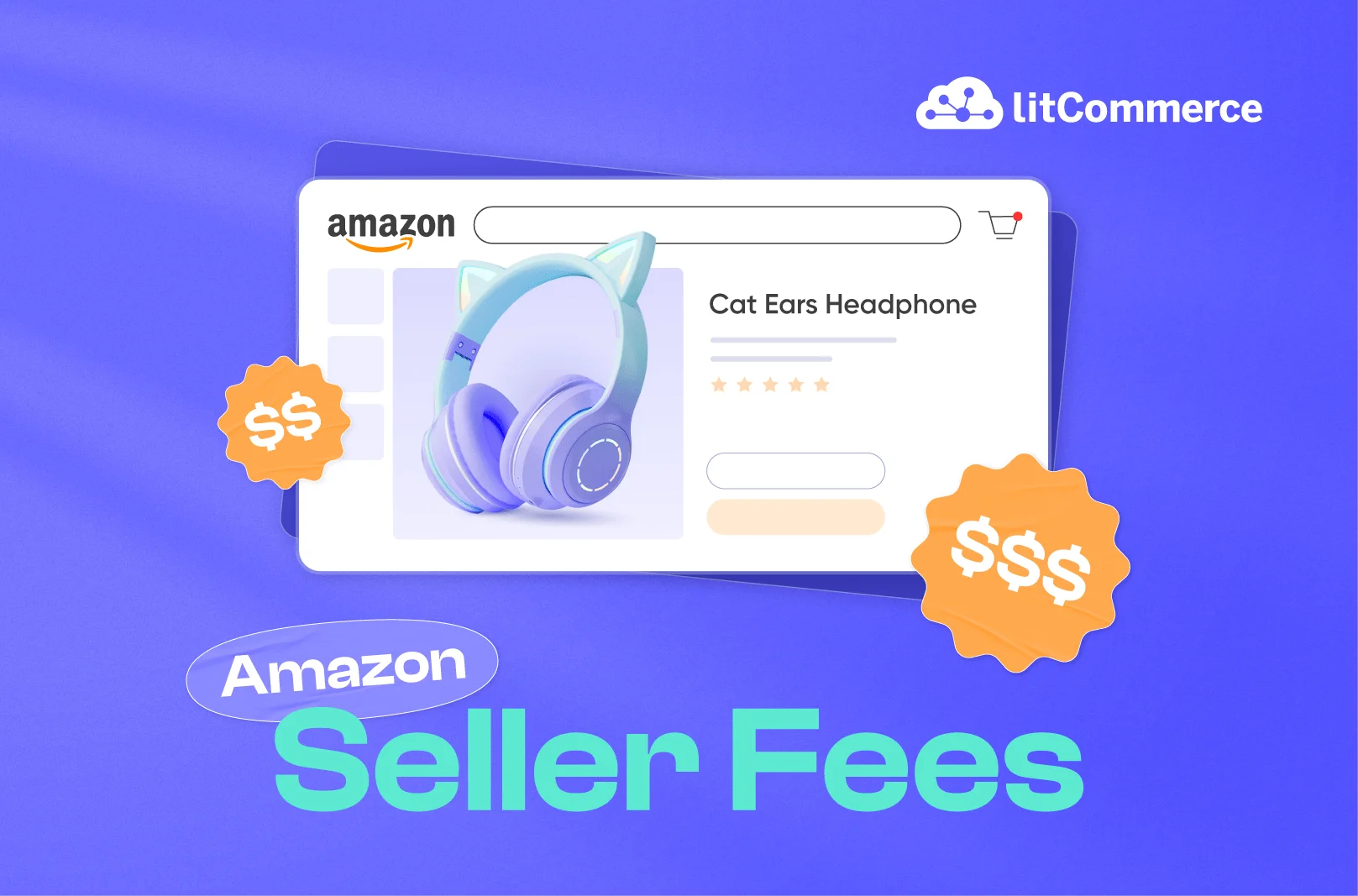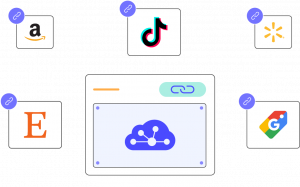If you plan to sell products on Amazon, it’s important to understand the Amazon seller fees you’ll need to pay. Amazon charges these fees for selling on their platform, and they can add up quickly. By understanding the cost of selling on Amazon and how to manage it, you can ensure that your selling experience is as profitable as possible.
Amazon Seller Fees – At A Glance
Here is a summary of Amazon seller fees.
1. Selling Plans:
- Individual Selling Plan: $0.99 per sold item (ideal for low-volume sellers with less than 40 items per month).
- Professional Selling Plan: $39.99 per month (unlimited listings, additional features).
2. Referral Fees:
- Percentage of your selling price, varying by product category (generally between 8% and 15%).
3. Fulfillment Fees:
- These Amazon FBA costs are only for Fulfillment by Amazon sellers: Storage, picking, packing, and shipping fees (variable depending on product size, weight, and storage duration). For standard-sized products, fulfillment fees can range from around $2.33 to $3.10 (as of April 15, 2024). For larger or bulky items, fees can be higher, potentially reaching $5 or more. There are also discounts for smaller, lower-priced items.
- FBM sellers (those who fulfill their own orders) do not have to pay Amazon’s fulfillment fees.
4. Additional Fees:
- Rental book service fees: $5.00 rental book service charge for each rental.
- Closing Fees: $1.80 per sold item (except media).
- High-volume listing fees: If you have a high volume of active, non-media listings that have not sold in 12 months, you will be charged a monthly fee of $0.005 per eligible listing to cover cataloging costs. The first 100,000 listings will be free of charge.
- Refund Administration Fee: $5 or 20% of the refunded referral fee (whichever is less).
5. Other Potential Fees:
- Long-Term Storage Fees: $6.90 per cubic foot or $0.15 per unit.
- Removal Fees: from $0.15 to $0.60 per unit.
- Returns: from $0.00 to $7.50 per unit
Now, let’s look at each seller’s fee on Amazon!
Amazon Seller Fees: Costs That All Sellers Pay
1. Referral fees
Amazon Seller referral fees are charges imposed on sellers for each product sold on Amazon. These Amazon seller fees are deducted from the sales price and paid to Amazon as a commission. These fees are based on the product category and the selling price.
Referral fees range from 6% to 45% of the selling price, with an average of 15%. As an Amazon seller, understanding referral fees is vital to ensure profitability.
Category | Referral fee percentage |
Amazon Device Accessories | 45% |
Appliances – Compact | · 15% of the total sales price less than $300.00 · 8% of the total sales price of more than $300.00 |
Appliances – Full-size | 8% |
Automotive and Powersports | 12% |
Base Equipment Power Tools | 12% |
Baby Products | · 8% of the total sales price less than $10.00 · 15% of a total sales price of more than $10.00 |
Backpacks, Handbags, and Luggage | 15% |
Beauty, Health, and Personal Care | · 8% of a total sales price less than $10.00 · 15% of a total sales price of more than $10.00 |
Business, Industrial, and Scientific Supplies | 12% |
Clothing and Accessories | · 5% for products with a total sales price of $15.00 or less · 10% for products with a total sales price greater than $15.00 and less than or equal to $20.00 · 17% for products with a total sales price greater than $20.00 |
Computers | 8% |
Consumer Electronics ¹ | 8% |
Electronics Accessories ² | · 15% of the total sales price less than $100.00 · 8% of the total sales price more than $100.00 |
Eyewear | 15% |
Fine Art | · 20% of Sales Proceeds less than $100 (with a minimum Referral Fee of $1.00) · 15% of Sales Proceeds from $100 to $1,000 · 10% of Sales Proceeds from $1,000 to $5,000 · 5% of Sales Proceeds of more than $5,000 |
Footwear | 15% |
Furniture | · 15% of the total sales price less than $200.00 · 10% of the total sales price of more than $200.00 |
Gift Cards | 20% |
Grocery and Gourmet | · 8% of a total sales price less than $15.00 · 15% of a total sales price of more than $15.00 |
Home and Kitchen | 15% |
Jewelry | · 20% of the total sales price less than $250.00 · 5% of the total sales price of more than $250.00 |
Lawn and Garden | 15% |
Lawn Mowers and Snow Throwers | · 15% of a total sales price of less than $500.00 · 8% of a total sales price of more than $500.00 |
Media – Books, DVD, Music, Software, Video | · 15% (plus a closing fee of $1.80 per item) |
Musical Instruments and AV Production | 15% |
Office Products | 15% |
Pet Supplies | 15%, except 22% for veterinary diets |
Sports and Outdoors | 15% |
Tools and Home Improvement | 15% |
Sellers can use the Amazon pricing calculator to estimate their referral fees accurately. The calculator considers the product category, selling price, and shipping fees to calculate the referral fees.
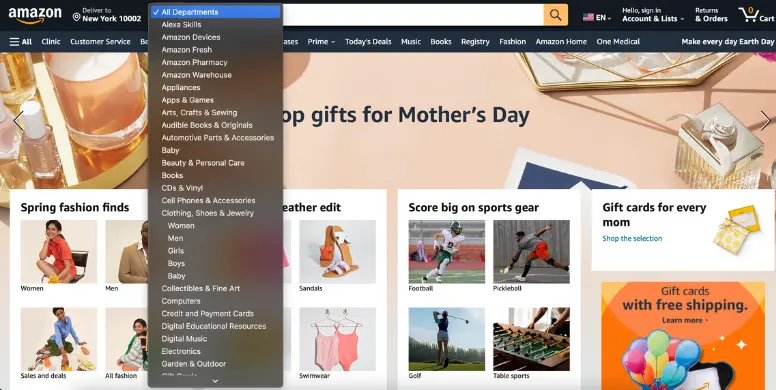
With all these costs, is selling on Amazon still worth it?
The answer is yes. Although the number of Amazon costs seems overwhelming, some of them are only applied to certain business sizes and products. Overall, the price is quite reasonable considering the vast number of customers the platform has to offer.
2. Variable closing fees
In addition to referral fees, Amazon Marketplace selling fees include variable closing fees on products sold under its Media categories. The fee is usually $1.80 for products including:
- Books
- DVDs;
- Music;
- Video;
- Software & Computer/Video Games;
- Video Game Consoles;
- Video Game Accessories.
For example, the variable closing fee for a book sold on Amazon was $1.80 per item. If a seller sold a book for $10, they would pay a referral fee of $1.50 (assuming a 15% referral fee), and a Variable Closing Fee of $1.80, for a total cost of $3.30.
Discover More Marketplaces Beyond Amazon
Variable closing fees on Amazon can be pricey for many sellers. But Amazon isn’t the only potential sales channel. Explore your other options now!
3. Subscription fees
When talking about selling on Amazon seller fees, merchants can choose between two selling plans: the Professional selling plan and the Individual selling plan. Adding to that, Amazon sellers can opt to pay per sale or month and modify/discontinue the fees at any time based on personal preference.
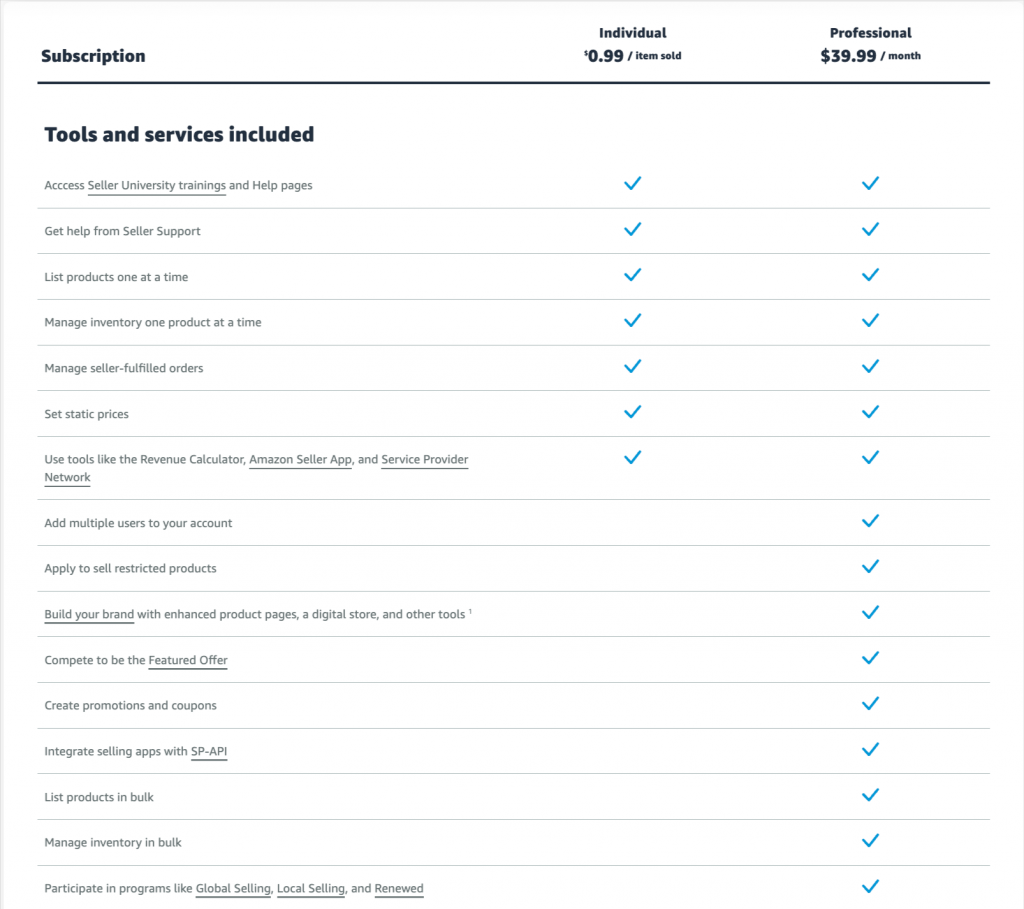
1. Professional selling plan
The Professional Selling Plan is a subscription service that costs $39.99 per month. This Amazon professional seller fees offer advanced features such as bulk upload tools and access to sell in more categories, making it a better fit for larger sellers selling a high product volume.
2. Individual Selling Plan
The Individual Selling Plan, on the other hand, does not have a monthly subscription fee. However, the individual seller Amazon fees charge $0.99 for each item you list. It is suitable for sellers who list only a few items per month and do not require access to advanced features.
To effectively manage your Amazon selling expenses, it’s crucial to understand the various seller fees. However, another critical aspect of running a successful Amazon business is considering your legal structure. If you’re unsure whether an LLC is the right choice for you, explore our guide on “Do I Need an LLC to Sell on Amazon?” for valuable insights.
Fulfillment by Amazon Fees
When it comes to “How much does it cost to sell on Amazon?”, a Fulfillment by Amazon (FBA) fee is a necessary charge. It is an Amazon service allowing sellers to store their products in Amazon’s fulfillment centers.
However, there are numerous associated fees that sellers should be aware of in order to ensure they are still making a profit. These Amazon seller FBA fees will include picking and packing, storage, and shipping. Let’s dive into each Amazon FBA cost sellers will have to pay.
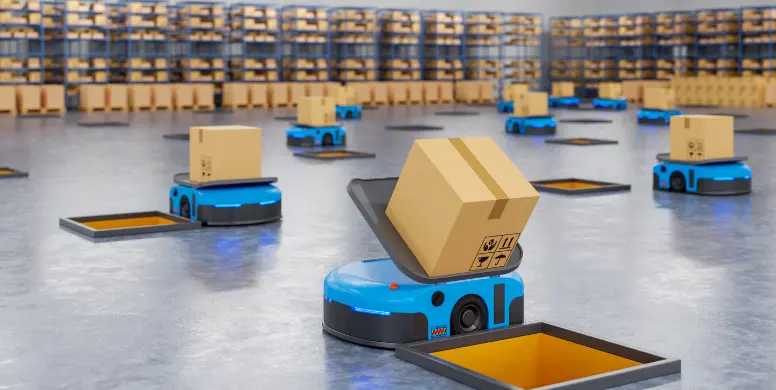
FBA Fulfillment fee
Talking about selling on Amazon costs, picking and packing fees cover the cost of picking the product from the fulfillment center, packing it in a box or envelope, and preparing it for shipment. These fees can vary based on the product’s size and weight, as well as the type of packaging used.
1. Fulfillment fees (excluding Apparel)
Meanwhile, storage fees are Amazon seller fees for the space sellers’ products occupy in Amazon’s fulfillment centers. These fees are charged monthly and vary depending on the time of year and the amount of space the products require.
The FBA storage fees are calculated based on several factors, including:
- Product size tier: The size of the product, which is determined by its dimensions and weight, is used to calculate the storage fees. Amazon has different size tiers for standard-size and oversized items.
- Current month: The time of year can affect the storage fees. Amazon charges higher prices for inventory stored during the peak holiday season (October through December).
- Product volume: The volume of the product, measured in cubic feet, is used to calculate the monthly inventory storage fee.
- Average daily units: This is the average number of units of a product a seller has in Amazon’s fulfillment centers daily. It is used to calculate the long-term storage fee.
- Storage utilization ratio: This is the amount of space a seller’s inventory occupies in Amazon’s fulfillment centers compared to the total the seller has. A higher utilization ratio can result in higher storage fees.
- Dangerous goods classification status: If a product is classified as hazardous material or dangerous goods, there may be additional fees for storage and handling.
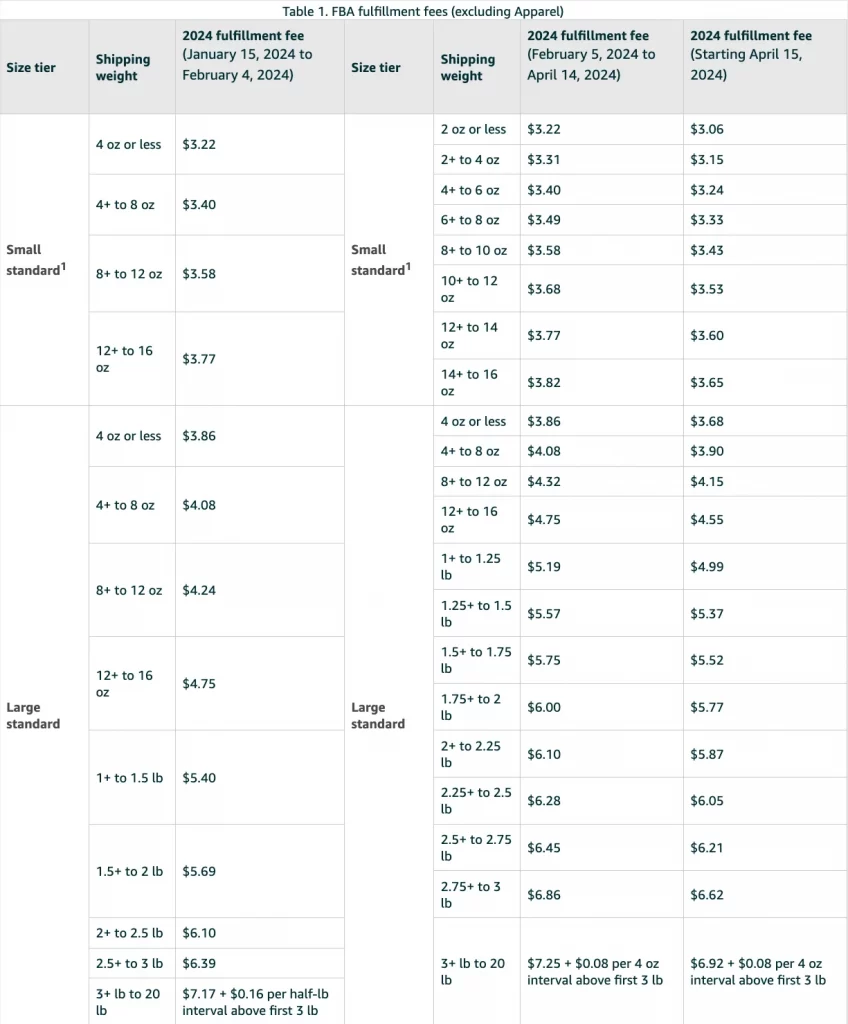

2. FBA fulfillment fees for Apparel
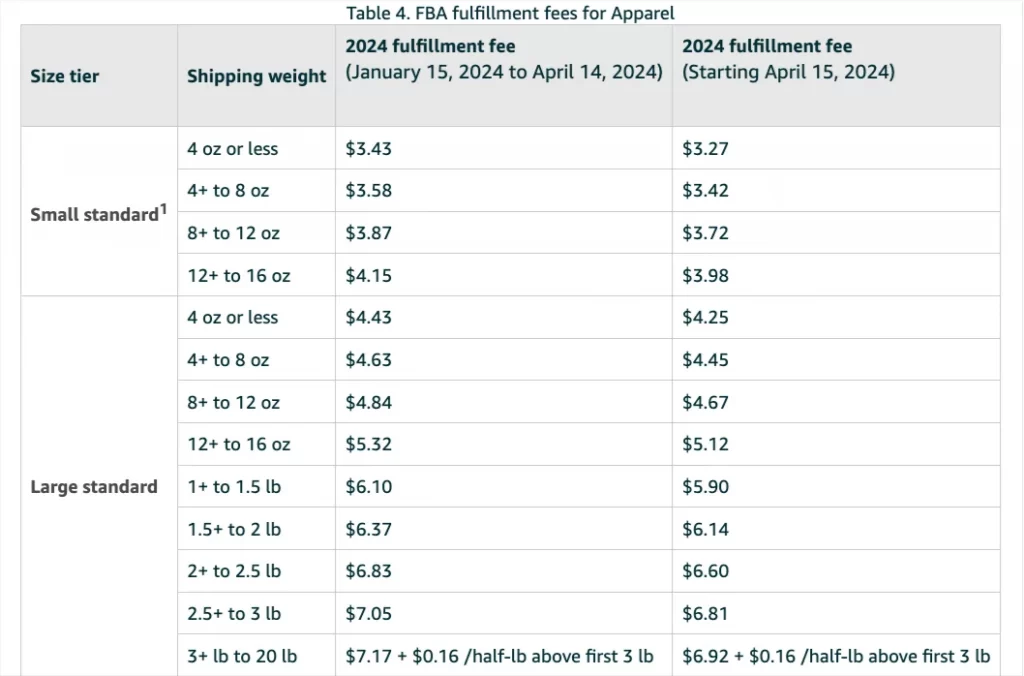


3. FBA fulfillment fees for dangerous goods
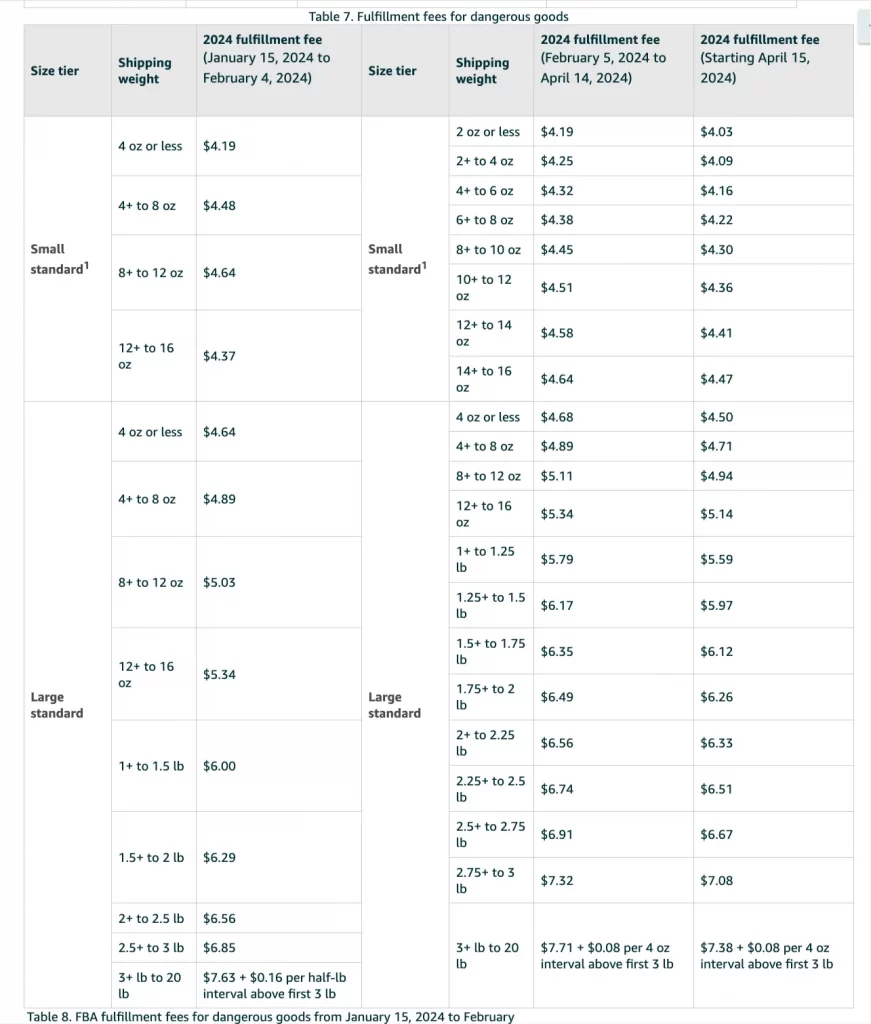
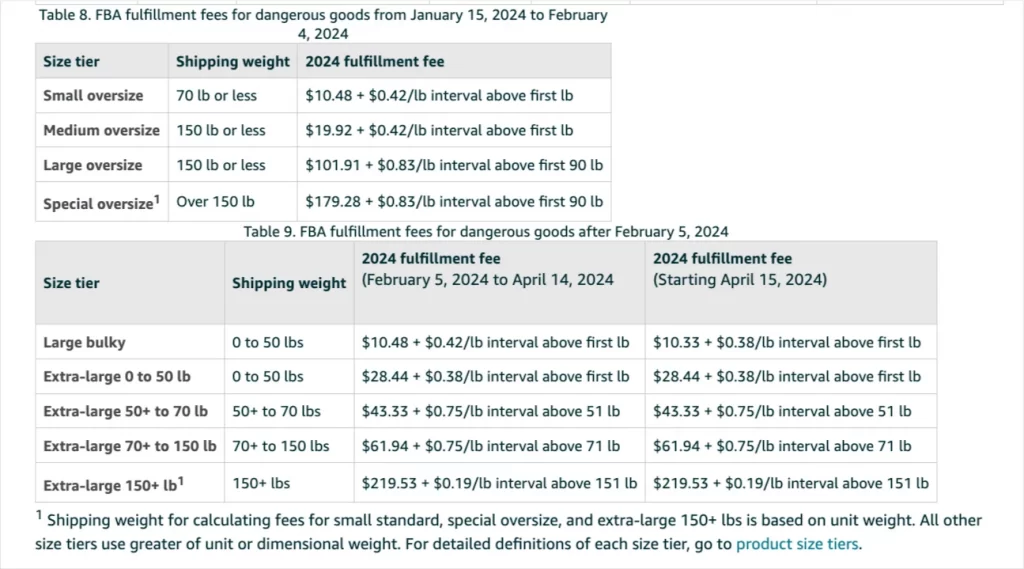
4. Low-Price FBA fees
Items priced below $10 will be eligible for Low-Price FBA rates, featuring identical delivery speeds as standard FBA. These Low-Price FBA rates come at a $0.77 discount compared to the standard FBA rates. Additionally, all Low-Price FBA rates include complimentary shipping for Prime members and standard shipping for non-Prime customers.
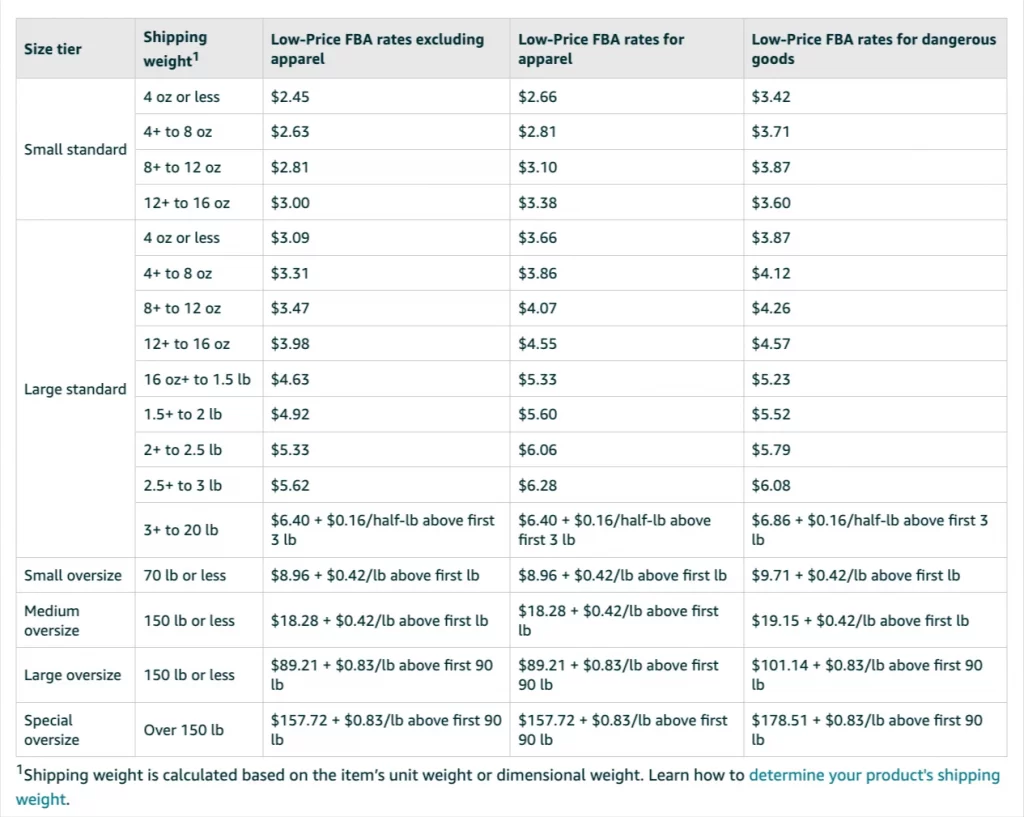
Storage fees
Meanwhile, storage fees are Amazon seller fees for the space sellers’ products occupy in Amazon’s fulfillment centers. These fees are charged monthly and vary depending on the time of year and the amount of space the products require.
Note: Amazon usually increases its FBA costs during peak seasons to cover increased operational costs due to higher order volume.
The FBA storage fees are calculated based on several factors, including:
- Product size tier: The size of the product, which is determined by its dimensions and weight, is used to calculate the storage fees. Amazon has different size tiers for standard-size and oversize items.
- Current month: The time of year can affect the storage fees. Amazon charges higher prices for inventory stored during the peak holiday season (October through December).
- Product volume: The volume of the product, measured in cubic feet, is used to calculate the monthly inventory storage fee.
- Average daily units: This is the average number of units of a product a seller has in Amazon’s fulfillment centers daily. It is used to calculate the long-term storage fee.
- Storage utilization ratio: This is the amount of space a seller’s inventory occupies in Amazon’s fulfillment centers compared to the total the seller has. A higher utilization ratio can result in higher of this Amazon seller fees.
- Dangerous goods classification status: If a product is classified as hazardous material or dangerous goods, there may be additional fees for storage and handling.
Long-term storage fees are charged to sellers for storing units in Amazon’s fulfillment centers for more than 365 days. Long-term storage fees are calculated based on an inventory snapshot taken on the 15th day of each month. The purpose of these fees is to encourage sellers to keep their inventory moving and to free up valuable storage space in Amazon’s fulfillment centers. This Amazon seller fee structure for long-term storage fees is $6.90 per cubic foot or $0.15 per unit, whichever is greater. These fees are taken twice yearly (in February and August) to give sellers ample time to manage their inventory.
If you want to start selling on Amazon without worrying about inventory and storage fees, check out this How to Sell on Amazon without Inventory guide now!
Removal fees
Next, removal fees are fees for sellers requesting to return or dispose of their inventory by Amazon. The purpose of these Amazon fees is to cover the costs associated with removing and processing the inventory. The fee structure for removal fees depends on the size and weight of the product, ranging from $0.15 to $0.60 per unit. It can cost higher for oversized or dangerous goods. It’s essential for sellers to carefully consider the removal fees before requesting to have their inventory returned or disposed of.
Return processing fees
Return processing fees are charged to sellers when a customer returns a product. These fees cover the costs associated with processing the return and returning the product to inventory.
The fee structure for return processing fees varies by product category and ranges from $0.00 to $7.50 per unit. Sellers should factor in these fees when setting their prices and provide high-quality products to minimize returns.
Other Amazon Seller Fees
Advertising fees
Last but not least, advertising fees are spent on Amazon’s advertising services, such as Sponsored Products or Sponsored Brands. These fees aim to promote the seller’s products and increase their visibility on Amazon.
The fee structure for advertising fees varies depending on the type of advertising campaign and the seller’s bidding strategy. Sellers can set a daily campaign budget and only pay when customers click on their ad. The fee amount is determined by the seller’s bid and the competition for the selected keywords.

Closing fees
The Amazon closing fee is an additional charge levied on top of other fees like referral fees and subscription fees. It applies to items in the following categories:
- Books
- DVD
- Music
- Software & Computer/Video Games
- Video Game Consoles
- Video Game Accessories.
When any item falling into one of the above categories is sold in the Amazon store, the seller is charged a $1.80 closing fee in addition to any other applicable fees.
Rental book service fees
This fee is specifically for textbooks that are eligible for Amazon’s rental program. A flat fee of $5.00 is charged for each rental transaction, regardless of the book’s price or rental duration. The fee is automatically deducted from your seller account when a textbook is rented.
High-volume listing fees
The fee is charged to cover the costs associated with storing and maintaining a large number of active SKUs on Amazon. It is calculated based on the highest number of active SKUs you have between the 5th and 31st days of the month. You will be charged $0.001 per active listing exceeding the first 1.5 million. The first 1.5 million active SKUs per marketplace are exempt from the fee.
For a comprehensive guide on understanding all Amazon fees, check out our in-depth post on How to Sell on Amazon
Refund administration fees
When you issue a refund on Amazon, they keep a portion of the original referral fee as a “Refund administration fee.”
- Book, music, video, and DVD products: If your refund percentage is 100%, then you don’t have to pay for this fee. In the case that your refund percentage is smaller than 100%, Amazon will keep the variable closing fee for that item. And you will get back a portion of the referral fee you paid when the item sold. However, you only get back a proportion of it, based on how much of the item price you refunded.
- Other product types: Lesser of $5 or 20% of referral fees. Note: If you refund a single item in an order, Amazon retains no more than $5 as a refund administration fee. If you refund two different items in an order, the platform retains up to $5 for each item, for a maximum of $10 as a refund administration fee.
Amazon Seller Fee Changes 2025
Overall
- Average increase of $0.15 per unit sold: Sellers will see a small fee increase compared to other logistics providers.
- New inbound and placement fees: Focus on placing inventory closer to customers for faster delivery at a lower cost.
- Reduced outbound and FBA fulfillment fees: Offset inbound and placement fees, with further discounts for specific programs.
- New low-inventory-level fee: Encourages maintaining adequate inventory for efficient fulfillment.
- Reduced non-peak monthly storage fees: Lower cost for storing standard-size products.
- New and expanded services: Reduced Amazon referral fees for apparel, improved Vine program, expanded FBA New Selection benefits and updated Supply Chain by Amazon offerings.
- Returns processing fee expansion: This applies to high-return products in all categories except apparel and shoes.
Key Changes
- Inbound placement service fee: Introduced for standard and large bulky products, with reduced fees for single-location shipments. (Effective March 1, 2024)
- Decreased FBA fulfillment fee: Average reduction of $0.20 for standard and $0.61 for large bulky products. (Effective April 15, 2024)
- Ships in Product Packaging (SIPP) program discount: Up to $1.32 per unit for eligible products. (Effective February 5, 2024)
- Low-inventory-level fee: This applies if the inventory level is low relative to sales. (Effective April 1, 2024)
- Reduced non-peak monthly storage fees: Average reduction of $0.09 per cubic foot for standard-size products. (Effective April 1, 2024)
- Reduced referral fees for apparel: 5% for under $15 and 10% for $15-$20. (Effective January 15, 2024).
Strategies to Minimize Amazon Seller Fees
As one of the top online marketplaces, Amazon remains the go-to option for millions of customers, suppliers, and sellers. However, understanding Amazon seller fees is essential to calculating your potential profits. Learn more about strategies to reduce Amazon marketplace selling and how to manage them in our guide on How to Start an Amazon FBA Business.
1. Select your products thoroughly
To minimize Amazon seller fees, sellers need to choose their products carefully. One strategy is to consider the selling on Amazon fees for different product categories. For instance, electronics, books, and home goods tend to have lower fees than categories like watches and jewelry. Sellers can lower their fees and increase their profits by choosing products with lower fees.
- Sellers should also consider the weight and size of the products they sell. Lightweight and easy-to-ship products, such as clothing or accessories, can help reduce fulfillment fees.
- Bundling products is another strategy to increase sales and reduce fees. By bundling products, sellers can offer a better value to customers while reducing their shipping costs.
2. Optimize your pricing on Amazon
To optimize your prices and reduce Amazon seller fees, consider each product’s referral fees and FBA fees. Adjust your prices accordingly to keep your costs low and profits high. Here are some highlights:
- Take the competition and demand for the product into account. Highly competitive products may require lower prices to attract customers, while products with high demand and low competition may allow higher prices.
- Use Amazon’s pricing tools and algorithms to monitor and adjust your prices in real time based on changes in demand, competition, and fees. Regularly analyze your costs and adjust your prices to ensure profitability.
- Choosing the right selling plan on Amazon can also impact your pricing strategy. Consider the fees and benefits of each plan to select the one that aligns with your pricing goals and budget.
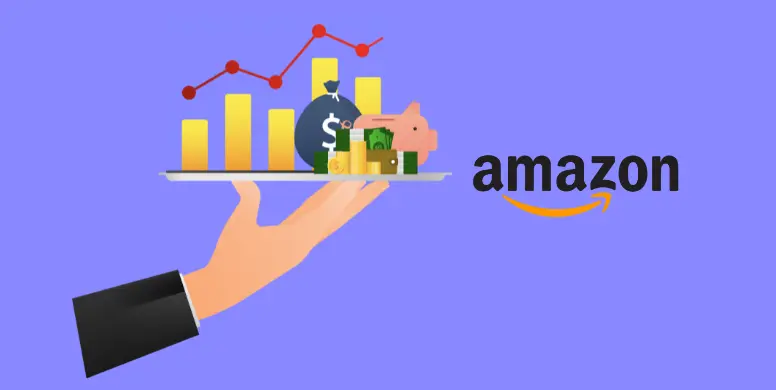
3. Get effective inventory management
Effective inventory management can help minimize Amazon seller fees. Follow these steps to do so:
- Research the fees associated with your selling plan and products on Amazon.
- Optimize your inventory levels to avoid long-term storage fees.
- Keep track of your inventory turnover rate and adjust your stock levels accordingly.
- Use Amazon’s tools to forecast demand and plan for seasonal fluctuations.
- Regularly review your inventory to identify slow-moving products and adjust pricing or promotions to increase sales.
Implementing these inventory management strategies can reduce your Amazon selling fees and improve your overall profitability.
4. Fulfillment options
Choosing the right fulfillment options is also crucial for decreasing Amazon seller fees. There are two options for fulfillment available, which are FBA (as mentioned above) and Fulfillment by Merchant (FBM). While FBA is a program where Amazon takes care of the entire order fulfillment process, FBM is a program where sellers handle the entire order fulfillment process.
Amazon Selling Fees – FAQs
- How much charge does Amazon take from sellers?
The exact Amazon seller fees can vary depending on the seller’s account type, product category, and other factors. Here are some of the possible charges that Amazon may apply to sellers:
- Referral Fees: Amazon charges referral fees on each item sold on the platform, which can range from 6% to 45% of the item’s sale price, depending on the product category.
- Fulfillment Fees: If a seller uses the FBA service, they will need to pay for storage and order fulfillment fees.
- Subscription Fees: Amazon charges a monthly subscription fee for sellers who use the Professional selling plan. For the Individual selling plan, at the same time, Amazon will take $0.99 per item sold.
- Advertising Fees: Amazon offers various advertising options for sellers to promote their products on the platform and charges fees for these services based on the ad type and performance.
- Is it free to be an Amazon seller?
No, it is not completely free to be an Amazon seller. Amazon offers two types of seller plans: Individual and Professional. The Individual account is free to sign up for, but you must pay a fee of $0.99 per item sold. The Professional account requires a monthly subscription fee of $39.99, but you will not be charged a fee per item sold.
Furthermore, there are many other fees associated with selling on Amazon, such as referral and fulfillment fees.
- How much does it cost to sell on Amazon?
The cost to sell on Amazon varies depending on the type of selling account you have and the item category you are selling. Here are the fixed costs every seller needs to be aware of:
- Selling Plan: If you sign for an Individual Seller Account, you will pay a per-item fee of $0.99 for each item you list. On the other hand, Professional Seller Account costs you $39.99 in total monthly, and you can list as many products as you wish.
- Fulfillment by Amazon (FBA): If you use Amazon’s FBA service to store and ship your products, you will be charged additional fees for storage, packaging, and shipping. These fees vary depending on the size and weight of your products and the time of year.
Final Words on How Much Does It Cost to Sell on Amazon
Although there are numerous Amazon seller fees, Amazon is still one of the best marketplaces for selling products. To be a successful Amazon seller, you’d better understand these fees and incorporate them into your pricing strategy. To gain more knowledge about selling on Amazon and connect with other sellers, visit our Blog, where you can find many valuable resources on the latest eCommerce trends. Whether you’re a new seller or an experienced one, you can gain some benefits from it.

